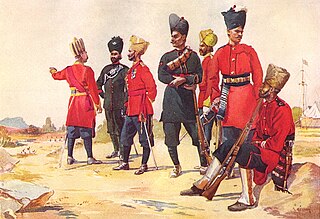Related Research Articles

The 76th Punjabis was an infantry regiment of the British Indian Army. It was raised by Captain Thomas Lane at Trichonopoly on 16 December 1776, as the 16th Carnatic Battalion. It was designated as the 76th Punjabis in 1903 and became the 3rd Battalion 1st Punjab Regiment in 1922. In 1947, it was allocated to the Pakistan Army, where it continues to exist as 3rd Battalion The Punjab Regiment.
The 108th Infantry were an infantry regiment of the British Indian Army. The regiment traces their origins to 1768, when they were raised as the 1st Battalion, Bombay Sepoys.

The 109th Infantry was an infantry regiment of the British Indian Army. The regiment traces its origins to 1768, when it was raised as the 5th Battalion, Bombay Sepoys.
The 64th Pioneers was a regiment of the British Indian Army. Originally serving as regular infantry it evolved into a specialist military pioneer unit performing engineering and construction tasks.
The 79th Carnatic Infantry was an infantry regiment of the British Indian Army. They could trace their origins to 1777, when the 20th Carnatic Battalion was raised from sub-units of the 1st, 3rd, 8th and 16th Carnatic Battalions.

The 61st Pioneers were an infantry regiment of the British Indian Army. They could trace their origins to 1758, when they were raised as the 1st Battalion Coast Sepoys.

The 63rd Palamcottah Light Infantry was an infantry regiment of the British Indian Army. The regiment could trace its origins to 1759, when it was raised as the 4th Battalion Coast Sepoys.
The 67th Punjabis were an infantry regiment of the British Indian Army. They could trace their origins to 1759, when they were raised as the 8th Battalion Coast Sepoys.
The 69th Punjabis were an infantry regiment of the British Indian Army. They could trace their origins to 1759, when they were raised as the 10th Battalion Coast Sepoys.
The 72nd Punjabis were an infantry regiment of the British Indian Army. They could trace their origins to 1759, when they were raised as the 16th Battalion Coast Sepoys.

The 73rd Carnatic Infantry was an infantry regiment originally raised in 1776 as the 13th Carnatic Battalion as part of the Presidency of Madras Army which was itself part of the Honourable East India Company Army. The presidency armies, like the presidencies themselves, belonged to the East India Company until the Government of India Act 1858 transferred all three presidencies to the direct authority of the British Crown. In 1903 all three presidency armies were merged into the British Indian Army. The unit was transferred to the Indian Army upon Indian Independence.
The 74th Punjabis were an infantry regiment of the British Indian Army. They could trace their origins to 1776, when they were raised as the 14th Carnatic Battalion.
The 80th Carnatic Infantry were an infantry regiment of the British Indian Army. They could trace their origins to 1777, when they were raised as the 21st Carnatic Battalion, by enlisting men from the 2nd, the 6th, the 12th and the 15th Carnatic Battalions.
The 81st Pioneers were an infantry regiment of the British Indian Army. They could trace their origins to 1786, when they were raised as the 28th Madras Battalion.
The 86th Carnatic Infantry was an infantry regiment originally raised in 1794 as the 36th Madras Native Infantry, part of the Presidency of Madras Army which was itself part of the Honourable East India Company Army. The presidency armies, like the presidencies themselves, belonged to the East India Company until the Government of India Act 1858 transferred all three presidencies to the direct authority of the British Crown. In 1903 all three presidency armies were merged into the British Indian Army. The unit was disbanded before Indian Independence.
The 88th Carnatic Infantry were an infantry regiment of the British Indian Army. They could trace their origins to 1798, when they were raised as the 2nd Battalion, 14th Madras Native Infantry.

The 103rd Mahratta Light Infantry were an infantry regiment of the British Indian Army. They could trace their origins to 1768, when they were raised as the 2nd Battalion, Bombay Sepoys. The regiment was first in action in the Mysore Campaign during the Third Anglo-Mysore War, quickly followed by the Battle of Seedaseer and the Battle of Seringapatam in the Fourth Anglo-Mysore War. Their next action was at Beni Boo Ali against pirates in Eastern Arabia and the Persian Gulf region led the East India Company to carry out a punitive expedition in 1819 to Ras al Khaimah which destroyed the pirate base and removed the threat from the Persian Gulf.

The 105th Mahratta Light Infantry were an infantry regiment of the British Indian Army. The regiment traces their origins to 1768, when they were raised as the 3rd Battalion, Bombay Sepoys.

The 110th Mahratta Light Infantry were an infantry regiment of the British Indian Army. The regiment traces their origins to 1797, when they were raised as the 2nd Battalion, 5th (Travancore) Regiment of Bombay Native Infantry.
The 77th Moplah Rifles were an infantry regiment of the British Indian Army. They could trace their origins to 1777, when they were raised as the 17th Carnatic Battalion.